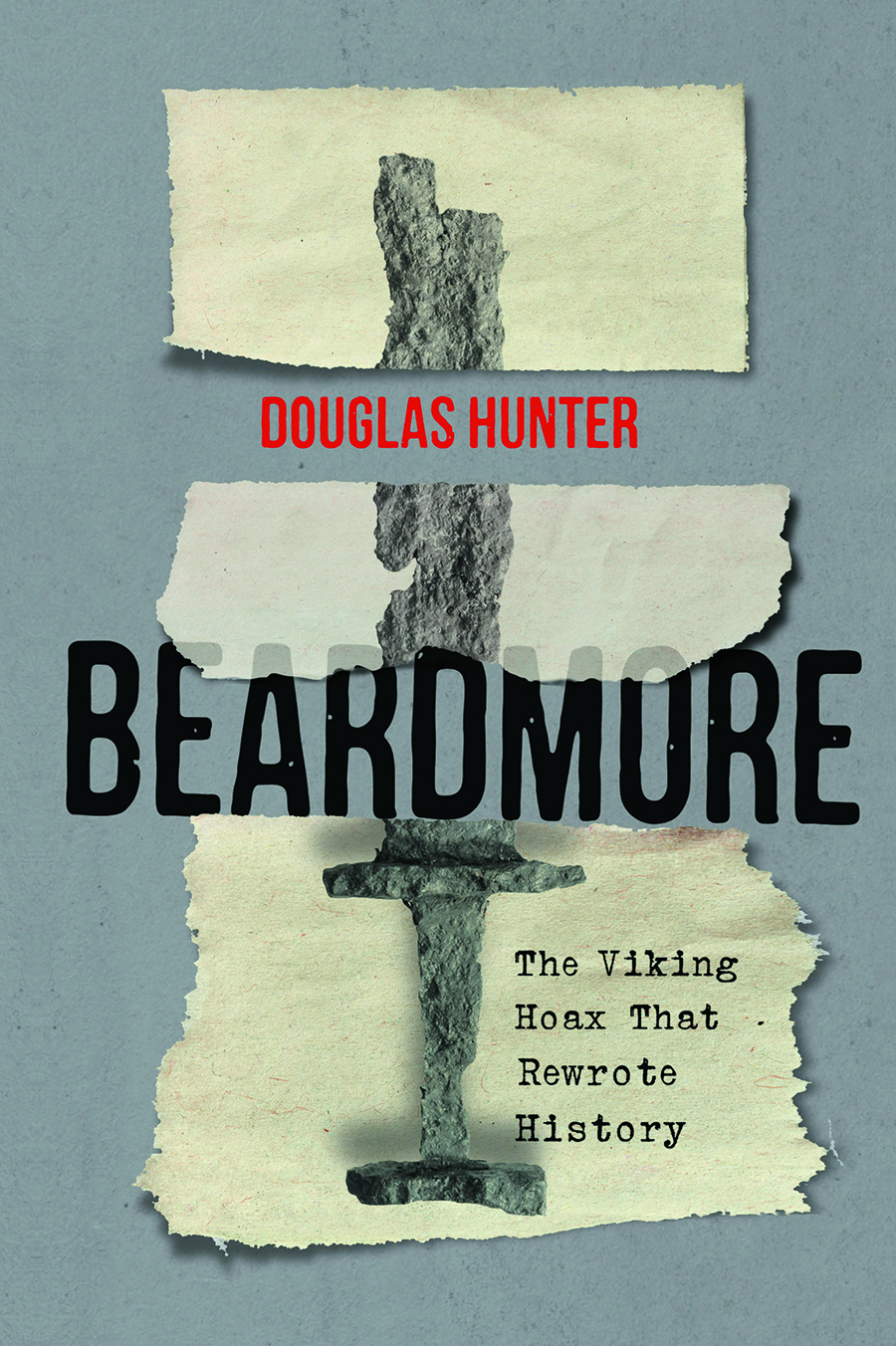Beardmore: The Viking Hoax that Rewrote History by Douglas Hunter
May 2019

Beardmore: The Viking Hoax
that Rewrote History
by Douglas Hunter
McGill-Queen’s University Press
$34.95
475 pages
When all was said and done, the Beardmore Hoax was just another instance of an all-too familiar tale. A handful of rusted man-made iron – two pieces of a broadsword, an axe head, and an unidentifiable shaped piece of metal – were proclaimed to be evidence of one of the greatest archaeological discoveries in North America’s history. Canada’s most eminent archaeologists accepted them as irrefutable proof that a millennium ago Norse adventurers had made their way overland from Hudson’s Bay to Lake Nipigon in north-western Ontario. It stretches credulity to the utmost that knowledgeable men could come to such a conclusion on the available evidence, which defied both common sense and reality, but they did.
The Hoax arose from an attempt by an obscure gold prospector named Eddy Dodd to promote the prospects of a claim he had staked at Beardmore, a whistle stop on Canadian National’s main line from eastern Canada through the northern Ontario wilderness and on into Port Arthur and Fort William. The absence of anything resembling evidence that intrepid Norse adventurers – often known as the Vikings – had made their way from the North Atlantic into Hudson’s Bay, and the lack of anything even resembling the river routes along which the Vikings universally travelled, meant nothing to those who chose to believe that the handful of relics were proof that Europeans did indeed stand on the shores of Lake Nipigon a thousand years ago.
Evidence that the Norse had reached North America was one of the great archaeological quests of the 19th and early 20th centuries. Vikings, among the greatest sea explorers ever known, made their way from their Scandinavian homeland throughout the Baltic, deep into the heart of Russia, and to the British Isles, conquered northeastern France, and established kingdoms in the Mediterranean. By 1000 AD they had sailed west across the North Atlantic to Iceland and Greenland. Although the Greenland settlements faded into oblivion in the 15th century, those in Iceland survive to this day. Surely then, the argument ran, such magnificent sailors had made their way to today’s North America. Two great sagas, those of the Greenlanders and Eirik the Red, described such adventures. All that was lacking was physical evidence that they had accomplished this.
Relics & runes
The Beardmore Find, in 1931, was not the first “discovery” to be proclaimed as evidence that Norsemen had indeed done so. In 1898, Swedish immigrants in northwestern Minnesota unearthed a rock which appeared to be covered by runes, an acknowledged form of Norse medieval writing. The Kensington Stone, as the find became known, was widely touted as being proof that Norse seamen had made their way to the spot where it was found. When displayed publicly in the Smithsonian Institute in Washington in 1948, National Geographic contemporaneously assured its readers that the Stone “was carved by white men who had travelled far into North America long before Columbus’s first voyage.” A century earlier, the Royal Society of Northern Antiquaries in Copenhagen proclaimed that a stone building in Newport, Rhode Island, was actually a ruined Norse church.
Dodd’s relics, then, found a receptive audience. Indeed, there is a convincing case that he may not have contemplated perpetrating a scam, but was merely angling for cash. As an unsuccessful prospector in the frantic Ontario gold rush of the early 1930s, he was looking for gold when he “discovered the sword and the axe.” He sold them for $500, a pittance if in fact they were real.
The truth behind the relics is that Dodd – their “discoverer” – found them in the basement of a house in which he had lived in Port Arthur. He thought them to be Norse (as indeed they were) and tried to use them to sustain interest in his efforts to locate gold at his claims near Beardmore. He planted the relics there; he knew from the start that any suggestion that they were left by Vikings was simply fraudulent and baseless.
This is the tangled tale that Douglas Hunter recounts forcefully and effectively in detail in Beardmore: The Viking Hoax That Rewrote History. The book is fascinating; “a good read” in the very best sense of the phrase, it will appeal strongly to those who want to know whether the Norse did indeed make their way into North America. But Hunter has written a far more important story than that, one which should be read by anybody interested in the presentation and propagation of “history,” whether or not they are interested in the Norse or the Hoax.
An irresistible discovery
The Ontario legislature created the Royal Ontario Museum, in Toronto, in 1912. A quarter-century later, it was the leading archaeological institution in the country, and Charles Trick Currelly, director of its Archaeology Division, was at the very top of his profession. Hunter tells us that “by the time the Beardmore relics surfaced, [he] had built the ROM’s Archeology Division into a marvel of breadth and depth.” Years later, outside consultants concluded that under his leadership the ROM had “reaped the fruits of an astute and energetic collector armed with much more money than most museum directors and operating in the period when large quantities of valuable objects became available.”
Yet Currelly lost his objectivity and surrendered his judgment from the moment that he first saw the Beardmore relics. Hunter describes them as being “a discovery that Currelly could not resist.” He had learnt of the find by a letter from Teddy Elliott, a high school teacher living in Fort William, who wrote to him on 5 November 1936. Elliott, and his colleague Thomas Leslie Tanton, a geologist with the Dominion Geological Survey, had met Dodd by happenstance one evening when Dodd clambered aboard the train at CNR’s Beardmore station and sat next to Elliott on a passenger train one night in July 1934. He was carrying the relics in a wooden case, and showed them to Elliott. Some two years later, when Elliott was teaching at the Kingston Collegiate Vocational Institute in Ontario, he became interested in what had become of them. He got in touch with Dodd; his missive to Currelly was the consequence. “The contents of Elliott’s letter electrified Currelly. The enclosed drawing of Dodd’s relics, he would recall, ‘sent me right up into the air,” and he asked the prospector to bring them to Toronto.
Currelly first saw the rusty metal objects when Dodd appeared at the ROM on 3 December 1936. He bought them after only the most cursory examination of their provenance. “The mere sight of the relics seemed to convince Currelly he simply had to own them.” The receipt for their purchase is dated that same day. A week later, in a letter to Elliott, Currelly said “This is the biggest historical find, I believe, that has ever been made in America and it will be to our advantage as a Province to have it come out in as thoroughly scientific a form as possible.” His conclusion was breathtaking, and the speed with which he reached it was more so, given the complete lack of any real examination of either the relics or their provenance.
Currelly spent his remaining years at the Museum trying to cope with the consequences of his foolish decision. His first reaction was to try to delay, diffuse, and derail any investigation into the relics and their provenance, and when that failed, he did whatever he could to frustrate efforts by others to do so. The tale is both sordid and riveting, a story of the abuse of power in an academic context.
The greater part of the book – more than three-quarters of it – is given over to Hunter’s description of the course of events during the years following ROM’s purchase of the relics. The story is enthralling, and his research is impressive, bolstered in every turn by documentary citations and a very extensive documentary record. I must acknowledge that as I read the account, I wondered why he was taking us through such a detailed analysis. It soon became clear, however, that his account of what happened after Currelly’s purchase was the heart of the book. Currelly, as I noted earlier, acted precipitously in buying the relics. It is not clear when he began to realize that he had made a colossal mistake in doing so, nor do the documents reveal why he decided to forego independent professional analysis of either the relics themselves or the process by which Dodd acquired them. The failure of his efforts to evade questions led him to take active steps to frustrate an examination.
The record is clear and beyond dispute. Currelly, a man of impeccable and welldeserved reputation in his field, went to great lengths to conceal his mistake. Elliott and Tanton, the two truth seekers, were both amateur archaeologists, and neither held a position even remotely close to the eminence on which Currelly stood. The failure of his initial tactics caused him to turn to more active measures; suborning his professional colleagues in an effort to deny the two men access to the academic journals, including the Canadian Historical Review. Currelly had good reason to regret his original enthusiastic endorsement of the finding; even so it is difficult to understand why he did not simply acknowledge that he had made a mistake. He chose not to do so. He persevered. The inevitable consequence was professional disgrace.

Beardmore: The Viking Hoax that Rewrote History
by Douglas Hunter
McGill-Queen’s University Press
$34.95
475 pages
Consequence & aftermath
It is important to note that Currelly was not alone in accepting the Beardmore relics as being both genuine and important. Donald Creighton, described by the Dictionary of Canadian Biography as being “his generation’s finest historian,” opined in his magisterial 1944 study Dominion of the North that “perhaps the deeply corroded Viking sword and axe which were discovered near Lake Nipigon in northern Ontario in 1930 belonged once to some members of a defiant expedition which struck out southwestward in an incredible overland journey from James Bay towards Lake Superior.” He later revised his opinion; in the book’s second edition [1957] he wrote “though it is conceivable that a body of Norsemen may have struck out on an expedition south westward from James Bay or Hudson Bay, the evidence so far produced in support of such an overland journey has either been rejected or is yet to have its authenticity satisfactorily established.”
The end of the story, when it came, was both swift and brutal. Edmund Carpenter, a young American archeologist then teaching at the University of Toronto, took up the cause to prove authentication. Public exposure followed, triggered by a 26 November 1956 story by Globe and Mail reporter, Robert L Gowe,“‘Viking Visitors’ Beardmore Cache of Relics Resolves into Battle of Archaeologists.” Carpenter, the paper said, “declares flatly no competent archaeologist can support any claims that had been made to the finding of Norse relics in the inner continent region.” Carpenter went on to say that Dodd’s account of finding the relics “was devastating and proved beyond reasonable doubt that the Beardmore Find is a colossal hoax.” Subsequent investigation by the ROM confirmed his statements. Very few detective stories end so definitively and with such complete vindication. The Beardmore Find ranks with the Piltdown Man and the Yale Vinland map in the archeologist’s Hall of Shame.
Hunter’s Beardmore is both fascinating and important. It is a wonderful tale of the courage and intellectual honesty of Elliott and Tanton, and the affirmation of a truth over a falsehood.
Afterthoughts
McGill-Queen’s University Press is noted for its fine editorial products. Beardmore: The Viking Hoax that Rewrote History is a fine demonstration of this. The editorial decision to include a “list of recurring characters,” identifying the men and women featured in the book, is more than welcome; without it, it would be difficult to follow the storyline throughout the book, given the vast panoply of characters, most of them only briefly on the stage.
Newfoundlanders will be struck by the number of links between the events described by Hunter and the Colony/Dominion of Newfoundland. George Robert Farrow Prowse, who taught high school in Winnipeg, was deeply involved in the early discussions of the Norse expeditions in North America. A son of Judge DW Prowse, author of A History of Newfoundland, he taught school in Manitoba for more than 20 years. His cartographical expertise led to his being consulted by many of those who wrote about the Canadian Arctic. Birgitta Wallace, an archaeologist and a leading member of the explorations led by Helge and Anne Stine Ingstad, which located and then confirmed the authenticity of L’Anse aux Meadows, was an important voice at several stages of the exposure of the Hoax. L’Anse aux Meadows, too, was once alleged to be fraudulent. Wallace was one of those who established that it is genuine.
The role of Elliott, the true hero in all of this, was perhaps the most intriguing of all the subplots in the Beardmore story. After retiring as a teacher, he became a Canadian civil servant in the 1940s, working with the federal Department of National Pensions and Wealth (as it was then called). Posted to Newfoundland after Confederation in 1949, he became the Regional Manager for the-then Department of Veterans Affairs. He lived here until 1954.



